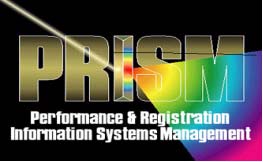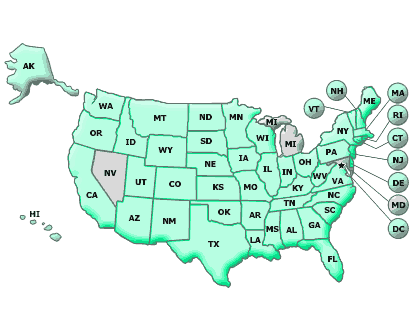|

Background
The Performance and Registration Information Systems Management Program (PRISM) originated as a pilot project mandated by Congress under section 4003 of the Intermodal Surface Transportation Efficiency Act of 1991 (ISTEA). The goal of the project was to explore the potential benefits of using State commercial vehicle registration sanctions as an incentive to improve motor carrier safety.
The PRISM pilot demonstration project was developed through a cooperative agreement between the Federal Motor Carrier Safety Administration (Formerly the Federal Highway Administration’s Office of Motor Carriers) and the Iowa Department of Transportation (DOT). In addition to Iowa, four other States—Colorado, Indiana, Minnesota and Oregon—participated in the PRISM pilot demonstration project.
The pilot officially ended on September 30, 1997. A final report assessing the feasibility, costs, and benefits of the PRISM program was submitted to Congress in 1998. The report proved conclusively that the possibility of State commercial vehicle registration sanctions could, indeed, serve as a powerful enforcement tool in Federal and State motor carrier safety improvement efforts.
In 1998 Congress authorized additional funding through the Transportation Equity Act for the 21st Century (TEA-21) to implement the PRISM program nationwide.
The PRISM Implementation Process
|
Step 1
|
Initial Briefing - At the State's request, an initial briefing of the PRISM program will be conducted for State officials by FMCSA staff. This briefing is meant to give State officials an outline of the PRISM program and its benefits to the State's safety initiatives.
|
|
|
|
Step 2
|
Letter of Intent
- If as a result of the initial briefing, a State decides to join the PRISM program, they must state their intentions to implement the program in a "Letter of Intent" to FMCSA. This letter should be sent to the FMCSA Division Administrator, who then forwards the letter to the FMCSA Office of Enforcement and Compliance in Washington, DC.
|
|
|
|
Step 3
|
In-depth Training
- Once the Letter of Intent is received, a two-day in-depth PRISM training session will be scheduled for the respective State. This training will include a general overview of the program and a thorough review of the grant requirements included in the PRISM Implementation Guide. As part of this process, the FMCSA PRISM Team and Division staff will use the Guide to lead the State through the process of developing their own plan. Group efforts will include the identification of responsible parties, development of implementation timelines, cost estimates, etc. Therefore, State attendees at this training should include IRP, ITS/CVO, and enforcement personnel with the authority to make decisions for the State.
|
|
|
|
Step 4
|
PRISM ImplementationPlan
- Following the two-day training session, PRISM staff will forward a draft version of the State's Implementation Plan to State officials for completion. If needed, PRISM staff will continue to work with State officials to finalize their Implementation Plan for submission. The Plan must specify how the State will meet the program requirements, time frames for completion, and associated costs.
|
|
|
|
Step 5
|
Finalize Plan & Award Grant
- Once a State finalizes its Implementation Plan, it should submit the Plan to the FMCSA Division Administrator for review, which then is forwarded to the FMCSA Office of Safety Programs for final approval. After the Plan has been approved by FMCSA, a grant will be issued to the State agency in the amount specified in the Implementation Plan.
|
|
|
|
Step 6
|
Implement PRISM
- Following the award of a PRISM Grant, the State is responsible for ensuring the program is implemented in their State according to the procedures, time lines, and costs identified in their Implementation Plan. States will also be required to intermittently report their progress to FMCSA. Funds for PRISM grants are typically established for a two-year period.
|
Participating States
As of December 1, 2008, 47 States plus the District of Columbia have joined the PRISM program. The only non-PRISM States currently (shaded gray on the map) are as follows:
Maryland, Michigan, and Nevada. 
Program Overview
The PRISM program includes two major processes—the Commercial Vehicle Registration Process, and the Motor Carrier Safety Improvement Process (MCSIP)—which work in parallel to identify motor carriers and hold them responsible for the safety of their operation. The performance of unsafe carriers is improved through a comprehensive system of identification, education, awareness, safety monitoring and treatment.
-
The Commercial Vehicle Registration Process
- A State's commercial vehicle registration process provides the framework for the PRISM program and serves two vital functions. First, it establishes a system of accountability by insuring that no vehicle is plated without identifying the carrier responsible for the safety of the vehicle during the registration year. Second, the use of registration sanctions serves as a powerful incentive for unsafe carriers to improve their safety performance.
The vehicle registration process ensures that all carriers engaged in interstate commerce are uniquely identified through a USDOT number when they register their vehicles. The safety fitness of each carrier can then be checked prior to issuing vehicle registrations. Thus, motor carriers that have been prohibited from operating in interstate commerce may then have their ability to register vehicles denied.
-
The Motor Carrier Safety Improvement Process (MCSIP)
- MCSIP is the means by which a motor carrier's safety is systematically tracked and improved. The process is designed to improve the safety performance of motor carriers with demonstrated poor safety performance through accurate identification, performance monitoring and treatment. MCSIP carriers that do not improve their safety performance face progressively more stringent penalties that may result in a Federal "unfit" or "imminent hazard" determination and the possible suspension of vehicle registrations by the State.
Benefits of PRISM
The results of the PRISM pilot far exceeded the FMCSA's expectations in terms of benefits, cost effectiveness, and operational feasibility. It also produced major safety, economic and productivity benefits as follows:
Accountability
- Identification of the motor carrier (via their USDOT number) responsible for the safe operation of the vehicle(s) being registered has clearly produced a major safety benefit. Accountability means that safety events (e.g., inspections, accidents, driver moving violations) affecting a PRISM-registered vehicle can be more accurately tied back to the responsible motor carrier.
A Performance-Based Approach to Safety Management
- The primary means of identifying potentially poor performing carriers is through an accumulation of carrier, vehicle, and driver-specific safety events that are linked to the motor carrier through the carrier's USDOT number.
Safestat
- By far, one of the most important safety benefits resulting from the PRISM pilot has been the development of the SafeStat prioritization methodology. SafeStat is a data-driven, performance-based algorithm used to identify potentially high-risk motor carriers for inclusion in the PRISM improvement process (MCSIP).
Improved Productivity
- The PRISM program was developed to meet the challenge of reducing the number of commercial vehicle crashes of a rapidly expanding motor carrier population. It has increased both the efficiency and effectiveness of Federal and State safety efforts through:
- A more accurate process for targeting the highest risk motor carriers, which allows for a more efficient allocation of scarce Compliance Review (CR) and roadside inspection resources.
- The use of "Warning Letters" as an effective, yet inexpensive, alternative to a Compliance Review for carriers with less severe safety performance problems.
Improved Data Quality
- The PRISM program has shown that an improvement in the accuracy and timeliness of data will result in better resource allocation and heightened efficiencies in the administration of major Federal and State safety programs. The data improvement initiatives in this project have significantly improved the accuracy and timeliness of critical accident and inspection data collected and uploaded by State motor carrier safety personnel. Several of the most notable data improvement initiatives resulting from the PRISM program are listed below.
- The development of a procedure for obtaining current census and operational data on motor carriers as part of the State's annual vehicle registration renewal process.
- The development of a procedure for using plate numbers as a means to more effectively assign inspection and accident data to the responsible motor carrier.
- The incorporation of a data correction element within the Motor Carrier Safety Improvement Process.
- The development of a nationally accepted procedure for correcting safety data errors.
- The funding of bar-code technology for registration documents and roadside inspectors to reduce data entry errors on accident and roadside inspection reports.
Improved Motor Carrier Safety
- The PRISM program pioneered the use of a "Warning Letter" as an alternative to an on-site Compliance Review for motor carriers with less severe safety problems. Alternatives such as this have taught us that the vast majority of motor carriers in the PRISM program improve their performance long before registration sanctions are applied. Thirty percent of the motor carriers that receive warning letters improve their safety performance on their own.
Customer Service
- The PRISM program improves customer service by allowing State registration agencies to issue USDOT numbers. This process promotes a "one-stop shop" concept by reducing the number of government agencies that a motor carrier must deal with to get on the road.
State Legislation for PRISM
In some States, legislation must be passed to provide the legal authority to impose vehicle registration sanctions against motor carriers that have been prohibited from operating by the FMCSA. The following sample language is provided for States that need enabling legislation:
- Grounds for Refusal of Registration:
If a commercial motor vehicle is being operated by a commercial motor carrier that has been prohibited to operate in interstate commerce by a Federal agency with authority to do so under Federal law.
-
Registration Suspension Based on Federal Prohibition from Operating in Interstate Commerce:
The Division of Motor Vehicles (or appropriate State agency) is authorized to suspend or revoke the registration of a commercial motor vehicle if the commercial motor carrier responsible for its safety has been prohibited from operating by a Federal agency.
How to Join PRISM
Federal grant funds are available to States that have received PRISM training and submit an acceptable PRISM Implementation Plan. The Federal Motor Carrier Safety Administration (FMCSA) provides 100 percent grants—no State match is required. States that are interested in participating in the program should request a briefing by FMCSA staff to explain the program and answer questions. If, after the introductory briefing, a State wants to join the program, a Letter of Intent must be sent to FMCSA and a training session will subsequently be scheduled to assist the State in developing an Implementation Plan. Upon approval of the plan by the FMCSA, the FMCSA Division Administrator and the appropriate official from the State agency that receives the grant must sign a Federal grant agreement.
Interested States should contact Mr. Bryan Price at 412-395-4816, or Mr. Tom Lawler at (202) 366-3866.
PDF Files may be viewed with Adobe Acrobat Reader

|
 Print
Print
